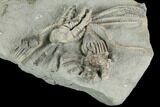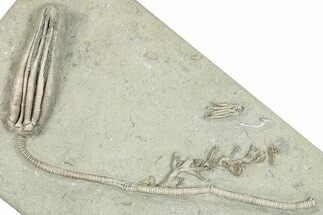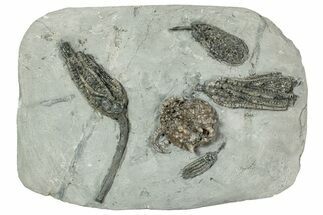This Specimen has been sold.
Five Species of 3D Crinoids on One Plate - Crawfordsville, Indiana
These are five fossil crinoids from the Edwardsville Formation crinoid beds near Crawfordsville, Indiana. This association includes a 2.3" long (including stem) Dizygocrinus montgomeryensis crinoid (#1), a 2.6" long Barycrinus rhombiferus crinoid (#2), a 1.8" long (longest measurment) Decadocrinus tumidulus crown (#3), a 2.3" long (including stem) Macrocrinus mundulus crinoid (#4) and a 1.6" wide crinoid crown of the species Agaricocrinus americanus (#5). There is a partial trilobite head near one edge of this rock.
These fossils were prepared using skillful air-abrasion techniques under a stereo microscope. It comes with an acrylic display stand.
#1 - Dizygocrinus montgomeryensis
#2 - Barycrinus rhombiferus
#3 - Decadocrinus tumidulus
#4 - Macrocrinus mundulus
#5 - Agaricocrinus americanus
These fossils were prepared using skillful air-abrasion techniques under a stereo microscope. It comes with an acrylic display stand.
#1 - Dizygocrinus montgomeryensis
#2 - Barycrinus rhombiferus
#3 - Decadocrinus tumidulus
#4 - Macrocrinus mundulus
#5 - Agaricocrinus americanus
Crinoids from the Ramp Creek Limestone were likely buried in sediment from nearby deltas during storms. The resulting siltstone deposits are soft enough that fossils can be extracted in exquisite, three-dimensional relief.
Crinoids, sometimes commonly referred to as sea lilies, are animals, not plants. They are echinoderms related to starfish, sea urchins, and brittle stars. Many crinoid traits are like other members of their phylum. Such traits include tube feet, radial symmetry, a water vascular system, and appendages in multiples of five (pentameral). They first appeared in the Ordovician (488 million years ago) and some species are still alive today.
Crinoids, sometimes commonly referred to as sea lilies, are animals, not plants. They are echinoderms related to starfish, sea urchins, and brittle stars. Many crinoid traits are like other members of their phylum. Such traits include tube feet, radial symmetry, a water vascular system, and appendages in multiples of five (pentameral). They first appeared in the Ordovician (488 million years ago) and some species are still alive today.
SPECIES
Dizygocrinus, Barycrinus, Decadocrinus, Macrocrinus & Agaricocrinus
LOCATION
Crawfordsville, Indiana
FORMATION
Edwardsville Formation
SIZE
5.8 x 3.9" rock
CATEGORY
SUB CATEGORY
ITEM
#122998
We guarantee the authenticity of all of our specimens.
 Reviews
Reviews













